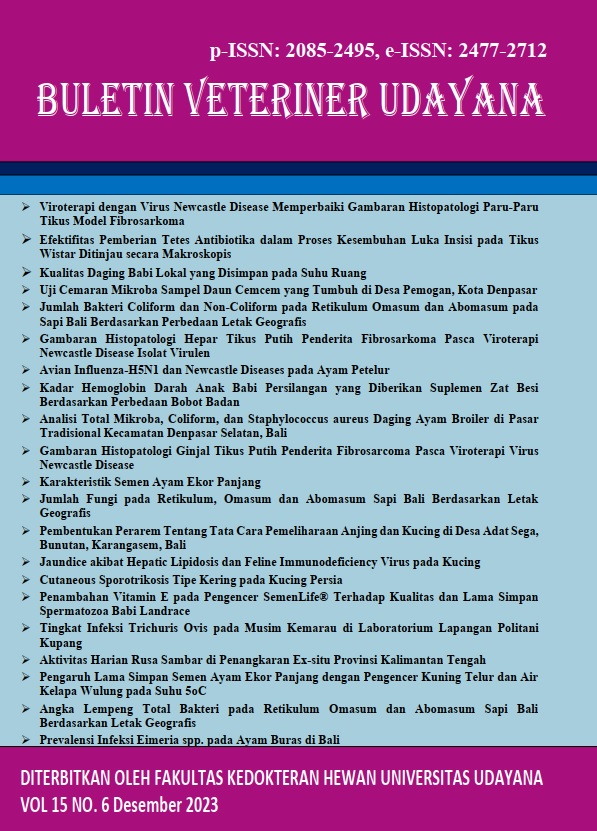TOTAL BACTERIAL PLATE NUMBERS IN RETICULUM OMASUM AND ABOMASUM AT BALI CATTLE BASED ON GEOGRAPHICAL LOCATION
Abstract
Bali cattle is one of Indonesia's original germplasm as a producer of the best quality meat compared to other local cattle, so it is important to continue to increase production. One of the efforts to increase the production of Bali cattle is to know the number of bacteria as an indicator that affects the digestive process of feed in different geographical areas. The purpose of this study was to determine the ALTB in the reticulum, omasum, and abomasum of Bali cattle based on geographical location and to determine differences in the ALTB in the reticulum, omasum, and abomasum of Bali cattle in the lowlands and highlands. Sampling in the form of contents of the reticulum, omasum, and abomasum of Bali cattle was carried out at the slaughterhouse. This study used a sample of 32 samples. The method used is the cultivation of bacteria on Nutrient Agar (NA) media with the pouring method. The data obtained are tabulated in the form of Average (Mean) ± Standard Deviation (SD). Then analyzed with the Independent Sample T-test to determine the significant value. The results showed that the amount of ALTB in the reticulum, omasum, and abomasum of Bali cattle reared in the lowlands were 238x105±37,1 CFU/g, 205x105±56,8 CFU/g, 197x105±34,1 CFU/g, respectively. and highlands, namely 248x105±43,1 CFU/g, 223x105±37,5 CFU/g, 211x105±28,2 CFU/g. The results of the Independent Sample T-test continued, namely the value of ALTB in each organ there was no significant difference (P> 0,05) in the lowlands and highlands. This study concluded that there was no significant difference in ALTB in the reticulum, omasum, and abomasum of Bali cattle reared in the highlands and the lowlands. Henceforth, it is necessary to research the characteristics of bacteria in the reticulum, omasum, and abomasum of Bali cattle.
Downloads
References
Direktorat Jenderal Peternakan dan Kesehatan Hewan Kementerian Pertanian. 2021. Statistik Peternakan dan Kesehatan Hewan 2021. Jakarta: Direktorat Jenderal Peternakan dan Kesehatan Hewan Kementerian Pertanian RI.
Fardiaz S. 1992. Mikrobiologi Pangan I. PT Gramedia Pustaka Utama, Jakarta.
Federer W. 1963. Experimental Design, Theory, and Application. Mac. Milan, New York.
Galyean ML, Tedeschi LO. 2014. Predicting Microbial Protein Synthesis in Beef Cattle: Relationship to Intakes of Total Digestible Nutrients and Crude Protein. J. Anim. Sci. 92(11): 5099- 5111.
Habeeb AAM, Marai FM, dan Kamal TH. 1992. Heat Stress. In: Farm Animal and The Environment. Phillips,C and D.Piggins (Eds.). C.A.B. Int., UK.
Hardjosubroto JM. Astuti. 1993. Buku Pintar Peternakan. PT Gramedia Widiasarana Indonesia, Jakarta.
Hoover WH, Miller TK. 1992. Rumen Digestive Physiology and Microbial Ecology. Bull. 708T. Agric. Forestry Exp. Stn., W.V. Univ., Morgantown, WV.
Hungate RE. 1966. The Rumen and its Micorbes. 2 nd Edition Academyc Press. New Yersey.
Jost DI, Aschemann M, Lebzien P, Joergensen RG, Sundrum A. 2013. Microbial Biomass in Faeces of Dairy Cows Affected by A Nitrogen Deficient Diet. Arch. Anim. Nutr. 67(2): 104-108.
LeDividich J, Herpin P, Geraert PA, and Fermorel M. 1994. Cold Stress. In: Farm Animals and The Environment. Phillips, C. and D.Piggins (Eds). C.A.B. Intr., U.
Mantrawan NCP, Besung INK, Suarjana IGK, Suwiti NK. 2018. Total Bakteri pada Berbagai Umur dan Lokasi Peternakan Sapi Bali di Nusa Penida. Bul. Vet. Udayana.10(2): 122-126.
Preston TR, Leng RA. 1997. Matching Ruminant Production System with Available Resources in the Tropic and Sub Tropics. 16t Printed by Int. Colour Prod., Aust.
Purbowati E, Rianto E, Dilaga WS, Lestari CMS, Adiwinarti R. 2014. Karakteristik Cairan Rumen, Jenis, dan Jumlah Mikrobia Dalam Rumen Sapi Bali. J. Bul. Peternakan. 38(1): 21-26.
Santosa, U. 1997. Pengembangan Agribisnis Penggemukan Pedet. G.M.Offset, Bandung.
Saputra DA, Maskur, Rozi T. 2019. Karakteristik Morfometrik (Ukuran Linier dan Lingkar Tubuh) Sapi Bali Yang Dipelihara Secara Semi Intensif di Kabupaten Sumbawa. J. Ilmu dan Teknol. Pet. Indon. 5: 67-75.
Simamora, Suhut, Salundik. 2006. Meningkatkan Kualitas Kompos. Agro Media Pustaka. Jakarta.
Suarjana IGK, Ketut Tono PG, Sudipa PH. 2021. Charcteristics of Rumen Fluid, pH and Number of Microbia. J. Vet. 4(1): 6-10.
Uhi HT, Parakkasi A, Haryanto B. 2006. Pengaruh suplemen katalitik terhadap karakteristik dan populasi mikroba rumen domba. Met. Pet. 29(1): 20-26.
Wales WJ, Kolver ES, Thorne PL and Egan AR. 2004. Diurnal Variation in Ruminal pH on the Digestibility of Highly Digestible Perennial Ryegrass During Continuous Culture Fermentation. J. Dairy Sci. 87: 1864–1871.





